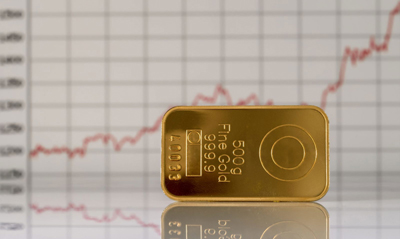How to Buy Gold for $900 per Ounce
James Hickman
 Today’s letter is about how to go back in time. Today’s letter is about how to go back in time.
A lot of us remember 2009 as a pretty tough economy. The whole world was in bad shape. Major banks had failed, panic had set in, governments were spending money hand over fist, and debts were rising fast. It was pretty brutal.
But if there’s anything nostalgic about 2009, it would be that, almost exactly 15 years ago, gold traded below $1,000 an ounce for the last time.
Today, the price of gold is hovering at its all-time high, more than $2,600 per ounce.
We’ve talked a lot about why that is. Central banks have been buying up physical gold, literally by the metric ton, primarily because they are looking to diversify a portion of their reserves outside of the US dollar.
And central banks are sitting on a LOT of US dollar reserves— more than $8 trillion.
It makes sense that they want to diversify. There’s so much more conflict in the world, and US global dominance is waning.
Iran is now flat-out threatening the US government and promising to retaliate if America provides military support to Israel. This would have been unthinkable even five years ago. But today, adversary nations have seized on the US government’s weakness. And foreign central banks— which, again, hold trillions of US dollar reserves— have noticed.
They’ve also noticed America’s outrageous national debt, and its annual budget deficits; in fact the most recent estimate by the Congressional Budget Office of the Fiscal Year 2024 is an incredible $1.8 trillion.
So obviously these central banks see a clear need to diversify. And gold is one of the best and easiest ways for them to do that.
The gold market is big. It can handle tens of billions of dollars of inflows at a time. Plus gold is universally valued around the world with a 5,000 year history of maintaining its value. No central banker is worried about whether or not they’ll be able to liquidate their gold holdings in the future.
But central banks only buy physical gold, i.e. piles and piles of physical gold bars. They do not buy gold mines… or gold miners.
This is why there is a historic anomaly in front of us: the price of gold has soared to an all-time high. But many gold companies are laughably cheap.
This is pretty strange when you think about it; a gold miner’s revenue is denominated in… gold! And many of these companies are starting to see soaring revenues and record profits. Yet their stock prices are still languishing.
For example, one gold producer we profiled in our premium research is trading at a Price to Earnings (P/E) of just 4x. It has almost no debt. And it produces a ton of Free Cash Flow.
The company has even blown away expectations and managed to produce 100,000 ounces of gold. Yet the stock price has barely budged.
What’s amazing is that the entire company is currently valued at less than the market price of that one year’s worth of gold that it mined.
But the kicker is how little it cost this company to produce that gold.
Their “All In Sustaining Cost” (AISC)— everything spent to pull that gold out of the ground, from mining to processing— was less than $1,000 per ounce.
And in our view, buying shares in an efficient, profitable, deeply undervalued mining company with such a low cost structure is almost like going back in time to 2009 and buying up gold at less than $1,000 per ounce… especially given that the company still has millions of ounces of proven gold reserves in the ground which it has yet to extract.
I’ve written many times before— we still see significant upside for gold. Especially if Kamala is elected.
Based on the type of spending she envisions, plus her weak “vibes” and “joy” leadership, I don’t expect the dollar to last as the global reserve currency beyond her first term.
Instead, central banks will continue to turn to gold. And when central banks converted just $80 billion— about 1%— of their US reserves into gold, the price increased to over $2,600 an ounce.
What would happen to the gold price if they converted 5%… or 20% of their US dollar reserves into gold?
Even buying physical gold, right now, at all time highs, would probably work out really well.
But buying a company whose revenue is gold, yet costs a fraction of that price, could work out even better.
Gold is just one of the real assets we talk about in Schiff Sovereign Premium.
We’ve been clear that America’s debt problems can only be solved by lower interest rates and more money printing from the Federal Reserve.
That’s why we don’t believe inflation is behind us, and why we believe so whole-heartedly in the value of real assets— critical resources that cannot be conjured out of thin air by governments and central banks.
This gold producer is just one example of these massively undervalued real asset companies we’ve named in Schiff Sovereign Premium— a highly educational, month-by-month guide that is designed to help you navigate the world from a position of strength, both personally and financially.
You can click here if you want to learn more about both the Plan B strategies and compelling investment research we present.

Simon Black, as James Hickman is more commonly known, is the Founder of Sovereign Man.
He is an international investor, entrepreneur, and a free man. His daily e-letter, Sovereign Letters, draws on his life, business and travel experiences to help readers gain more freedom, more opportunity, and more prosperity.
Hickman is a lifelong entrepreneur and investor that’s traveled to more than 120 countries on all seven continents. In addition, he’s started, invested in, or acquired businesses all over the world.
He is a graduate of the United States Military Academy at West Point and served in the US Army as an intelligence officer during Operation Enduring Freedom and Operation Iraqi Freedom.
Hickman founded a South America-based agriculture company that has become one of the leading producers in its industry. A few years ago, he acquired a prominent retail brand in Australia, purchasing the business from the former 1980s era rock star who founded it.
His other business ventures have included starting a boutique, private investment bank that boasts some of the highest levels of liquidity and solvency in the world, and investing in companies from Colombia to Uzbekistan. He also serves on numerous Boards of Directors, and previously served as Chairman of company listed on a major stock exchange.
Writing under the pen name Simon Black, he has also written extensively on business incorporation and tax residency establishment in Puerto Rico, and is a proponent of investing in gold and silver as a hedge against inflation.
He is a also a prolific writer on topics ranging from second residency and citizenship, Golden Visas and portfolio diversification, to estate and retirement planning, asset protection, tax optimization and US Opportunity Zones.
www.schiffsovereign.com
| 

